Supply Chain Management: Critical Analysis of Human Capital Article
VerifiedAdded on 2023/04/11
|8
|1217
|353
Essay
AI Summary
This essay provides a critical analysis of an article discussing the importance of human resources in supply chain management amidst technological advancements. The analysis focuses on the changing skill requirements for human resources and the need for talent development within the sector. The essay identifies the article's strengths, such as highlighting strategies for talent management, and weaknesses, including the lack of discussion on the challenges posed by automation and the potential for technology to substitute human labor. It argues that future strategies should focus on developing technologies that complement human labor, ensuring sustainable development and maintaining the demand for skilled workers. The essay concludes by emphasizing the unique perspective of the chosen article and recommending a shift towards complementing technologies over substituting ones in the supply chain process.

Running head: SUPPLY CHAIN MANAGEMENT
Supply chain management
Name of the student
Name of the university
Author note
Supply chain management
Name of the student
Name of the university
Author note
Paraphrase This Document
Need a fresh take? Get an instant paraphrase of this document with our AI Paraphraser
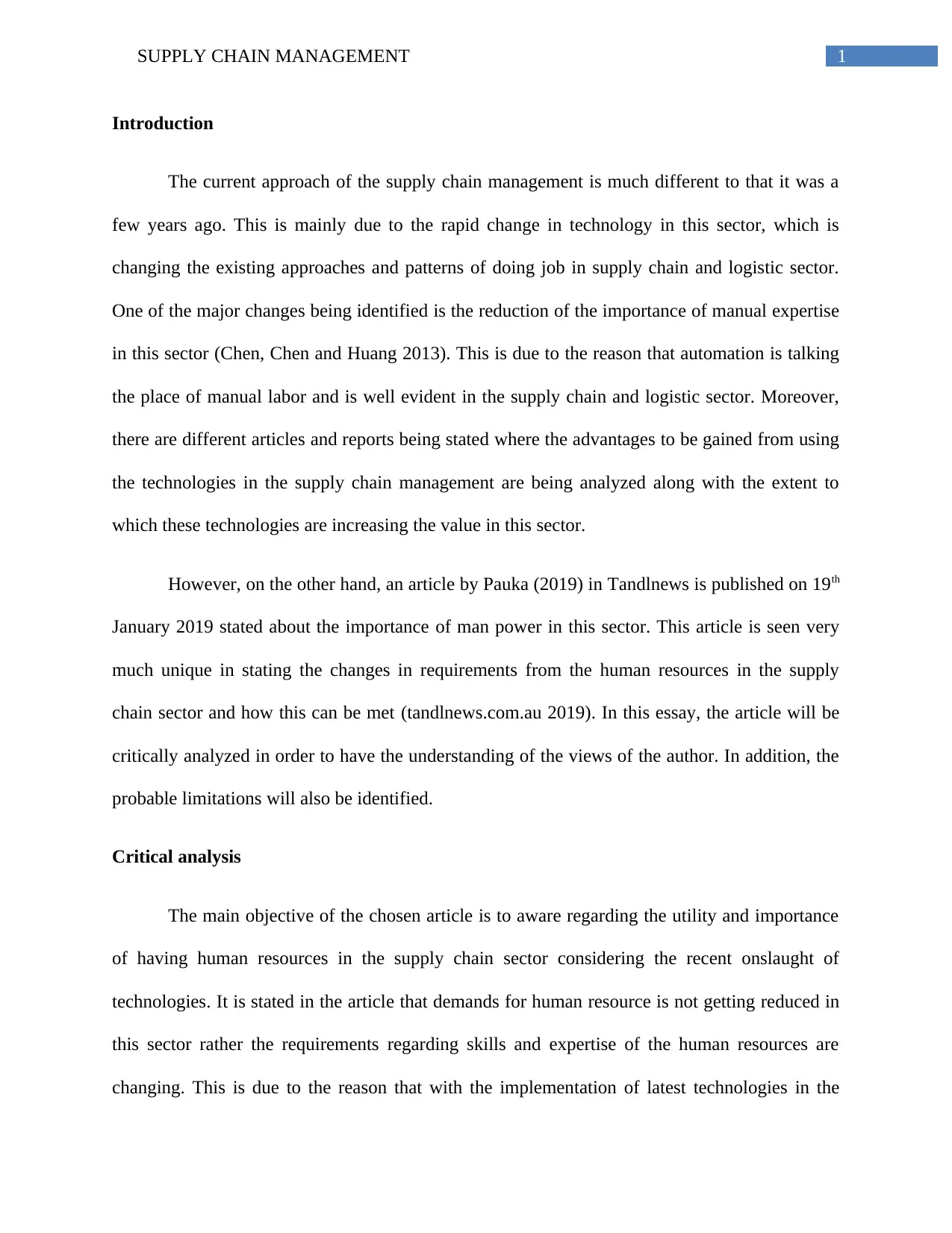
1SUPPLY CHAIN MANAGEMENT
Introduction
The current approach of the supply chain management is much different to that it was a
few years ago. This is mainly due to the rapid change in technology in this sector, which is
changing the existing approaches and patterns of doing job in supply chain and logistic sector.
One of the major changes being identified is the reduction of the importance of manual expertise
in this sector (Chen, Chen and Huang 2013). This is due to the reason that automation is talking
the place of manual labor and is well evident in the supply chain and logistic sector. Moreover,
there are different articles and reports being stated where the advantages to be gained from using
the technologies in the supply chain management are being analyzed along with the extent to
which these technologies are increasing the value in this sector.
However, on the other hand, an article by Pauka (2019) in Tandlnews is published on 19th
January 2019 stated about the importance of man power in this sector. This article is seen very
much unique in stating the changes in requirements from the human resources in the supply
chain sector and how this can be met (tandlnews.com.au 2019). In this essay, the article will be
critically analyzed in order to have the understanding of the views of the author. In addition, the
probable limitations will also be identified.
Critical analysis
The main objective of the chosen article is to aware regarding the utility and importance
of having human resources in the supply chain sector considering the recent onslaught of
technologies. It is stated in the article that demands for human resource is not getting reduced in
this sector rather the requirements regarding skills and expertise of the human resources are
changing. This is due to the reason that with the implementation of latest technologies in the
Introduction
The current approach of the supply chain management is much different to that it was a
few years ago. This is mainly due to the rapid change in technology in this sector, which is
changing the existing approaches and patterns of doing job in supply chain and logistic sector.
One of the major changes being identified is the reduction of the importance of manual expertise
in this sector (Chen, Chen and Huang 2013). This is due to the reason that automation is talking
the place of manual labor and is well evident in the supply chain and logistic sector. Moreover,
there are different articles and reports being stated where the advantages to be gained from using
the technologies in the supply chain management are being analyzed along with the extent to
which these technologies are increasing the value in this sector.
However, on the other hand, an article by Pauka (2019) in Tandlnews is published on 19th
January 2019 stated about the importance of man power in this sector. This article is seen very
much unique in stating the changes in requirements from the human resources in the supply
chain sector and how this can be met (tandlnews.com.au 2019). In this essay, the article will be
critically analyzed in order to have the understanding of the views of the author. In addition, the
probable limitations will also be identified.
Critical analysis
The main objective of the chosen article is to aware regarding the utility and importance
of having human resources in the supply chain sector considering the recent onslaught of
technologies. It is stated in the article that demands for human resource is not getting reduced in
this sector rather the requirements regarding skills and expertise of the human resources are
changing. This is due to the reason that with the implementation of latest technologies in the

2SUPPLY CHAIN MANAGEMENT
supply chain sector, job roles are getting changed and the human resources are being expected
with more diverse skills and expertise to deal with these technological advancements. Hence, as
the author, the demand for skilled man power will never get reduced rather it will get changed by
time (tandlnews.com.au 2019). On the other hand, this article has also states about the negligence
being shown by the current organizations in the supply chain and logistic sector regarding the
talent development. As the survey stated in this article, only 28 percent of the total respondents
stressed about the importance of talent development in the supply chain sector. Hence, the gap
between the approaches of the leading organizations and requirements is getting wider.
It can be concluded that the objectives of this article are very much distinctive as it took a
different approach towards stating the importance of human resources in the supply chain
management and the extent to which current industrial scenario is incompetent to adopt with the
change. Moreover, it can also be concluded from the chosen article that talent development is
one of the major elements that should be considered in this sector in the current time in order to
have the flow and supply of skilled human resources at any point of time (Lin 2014). In addition,
strength for this article identified is the discussion regarding the ways talent management
required in this sector. There are different strategies stated by the author, which can help the
current gap between the human resources and technologies evident in the supply chain and
logistic sector.
There are few weaknesses also being identified in this article with one being the lack of
discussion regarding the challenge being faced by human resources due to automation. In this
article, it is stated by the authors that initiation of technologies have only change the requirement
from the human resources and it is not substitute (Coustasse, Tomblin and Slack 2013).
However, in the practical situation, there are number of instances where automation is
supply chain sector, job roles are getting changed and the human resources are being expected
with more diverse skills and expertise to deal with these technological advancements. Hence, as
the author, the demand for skilled man power will never get reduced rather it will get changed by
time (tandlnews.com.au 2019). On the other hand, this article has also states about the negligence
being shown by the current organizations in the supply chain and logistic sector regarding the
talent development. As the survey stated in this article, only 28 percent of the total respondents
stressed about the importance of talent development in the supply chain sector. Hence, the gap
between the approaches of the leading organizations and requirements is getting wider.
It can be concluded that the objectives of this article are very much distinctive as it took a
different approach towards stating the importance of human resources in the supply chain
management and the extent to which current industrial scenario is incompetent to adopt with the
change. Moreover, it can also be concluded from the chosen article that talent development is
one of the major elements that should be considered in this sector in the current time in order to
have the flow and supply of skilled human resources at any point of time (Lin 2014). In addition,
strength for this article identified is the discussion regarding the ways talent management
required in this sector. There are different strategies stated by the author, which can help the
current gap between the human resources and technologies evident in the supply chain and
logistic sector.
There are few weaknesses also being identified in this article with one being the lack of
discussion regarding the challenge being faced by human resources due to automation. In this
article, it is stated by the authors that initiation of technologies have only change the requirement
from the human resources and it is not substitute (Coustasse, Tomblin and Slack 2013).
However, in the practical situation, there are number of instances where automation is
⊘ This is a preview!⊘
Do you want full access?
Subscribe today to unlock all pages.

Trusted by 1+ million students worldwide
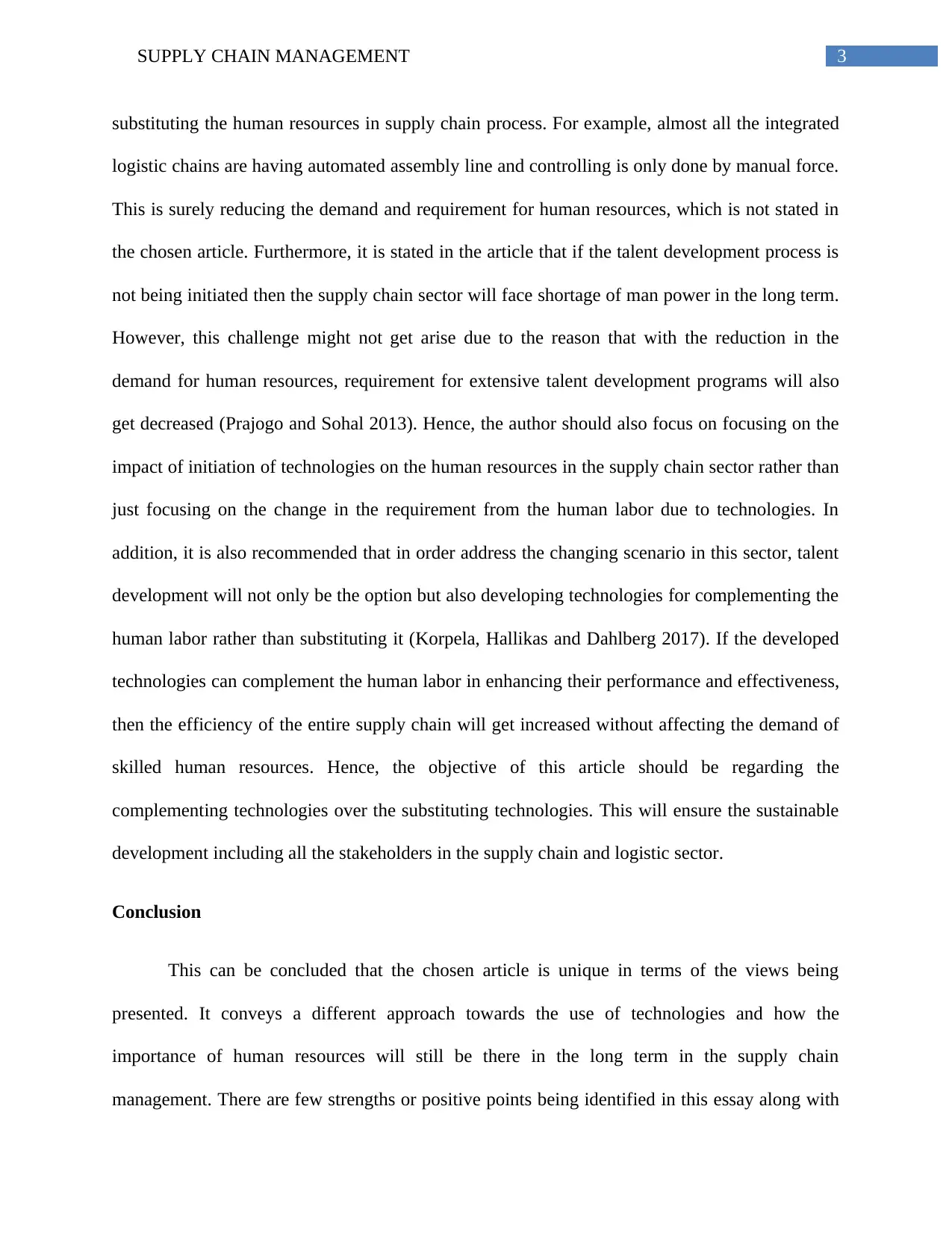
3SUPPLY CHAIN MANAGEMENT
substituting the human resources in supply chain process. For example, almost all the integrated
logistic chains are having automated assembly line and controlling is only done by manual force.
This is surely reducing the demand and requirement for human resources, which is not stated in
the chosen article. Furthermore, it is stated in the article that if the talent development process is
not being initiated then the supply chain sector will face shortage of man power in the long term.
However, this challenge might not get arise due to the reason that with the reduction in the
demand for human resources, requirement for extensive talent development programs will also
get decreased (Prajogo and Sohal 2013). Hence, the author should also focus on focusing on the
impact of initiation of technologies on the human resources in the supply chain sector rather than
just focusing on the change in the requirement from the human labor due to technologies. In
addition, it is also recommended that in order address the changing scenario in this sector, talent
development will not only be the option but also developing technologies for complementing the
human labor rather than substituting it (Korpela, Hallikas and Dahlberg 2017). If the developed
technologies can complement the human labor in enhancing their performance and effectiveness,
then the efficiency of the entire supply chain will get increased without affecting the demand of
skilled human resources. Hence, the objective of this article should be regarding the
complementing technologies over the substituting technologies. This will ensure the sustainable
development including all the stakeholders in the supply chain and logistic sector.
Conclusion
This can be concluded that the chosen article is unique in terms of the views being
presented. It conveys a different approach towards the use of technologies and how the
importance of human resources will still be there in the long term in the supply chain
management. There are few strengths or positive points being identified in this essay along with
substituting the human resources in supply chain process. For example, almost all the integrated
logistic chains are having automated assembly line and controlling is only done by manual force.
This is surely reducing the demand and requirement for human resources, which is not stated in
the chosen article. Furthermore, it is stated in the article that if the talent development process is
not being initiated then the supply chain sector will face shortage of man power in the long term.
However, this challenge might not get arise due to the reason that with the reduction in the
demand for human resources, requirement for extensive talent development programs will also
get decreased (Prajogo and Sohal 2013). Hence, the author should also focus on focusing on the
impact of initiation of technologies on the human resources in the supply chain sector rather than
just focusing on the change in the requirement from the human labor due to technologies. In
addition, it is also recommended that in order address the changing scenario in this sector, talent
development will not only be the option but also developing technologies for complementing the
human labor rather than substituting it (Korpela, Hallikas and Dahlberg 2017). If the developed
technologies can complement the human labor in enhancing their performance and effectiveness,
then the efficiency of the entire supply chain will get increased without affecting the demand of
skilled human resources. Hence, the objective of this article should be regarding the
complementing technologies over the substituting technologies. This will ensure the sustainable
development including all the stakeholders in the supply chain and logistic sector.
Conclusion
This can be concluded that the chosen article is unique in terms of the views being
presented. It conveys a different approach towards the use of technologies and how the
importance of human resources will still be there in the long term in the supply chain
management. There are few strengths or positive points being identified in this essay along with
Paraphrase This Document
Need a fresh take? Get an instant paraphrase of this document with our AI Paraphraser
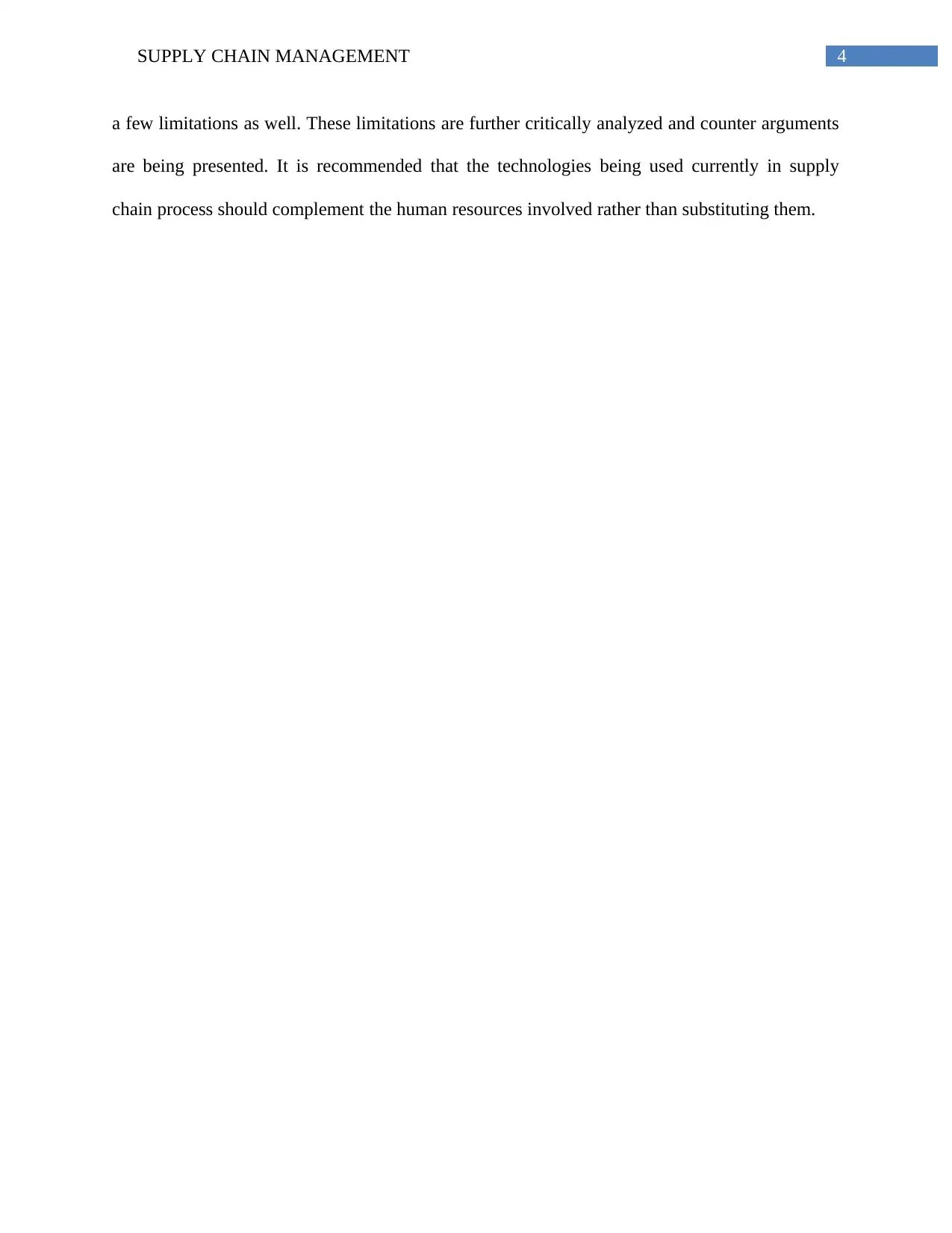
4SUPPLY CHAIN MANAGEMENT
a few limitations as well. These limitations are further critically analyzed and counter arguments
are being presented. It is recommended that the technologies being used currently in supply
chain process should complement the human resources involved rather than substituting them.
a few limitations as well. These limitations are further critically analyzed and counter arguments
are being presented. It is recommended that the technologies being used currently in supply
chain process should complement the human resources involved rather than substituting them.
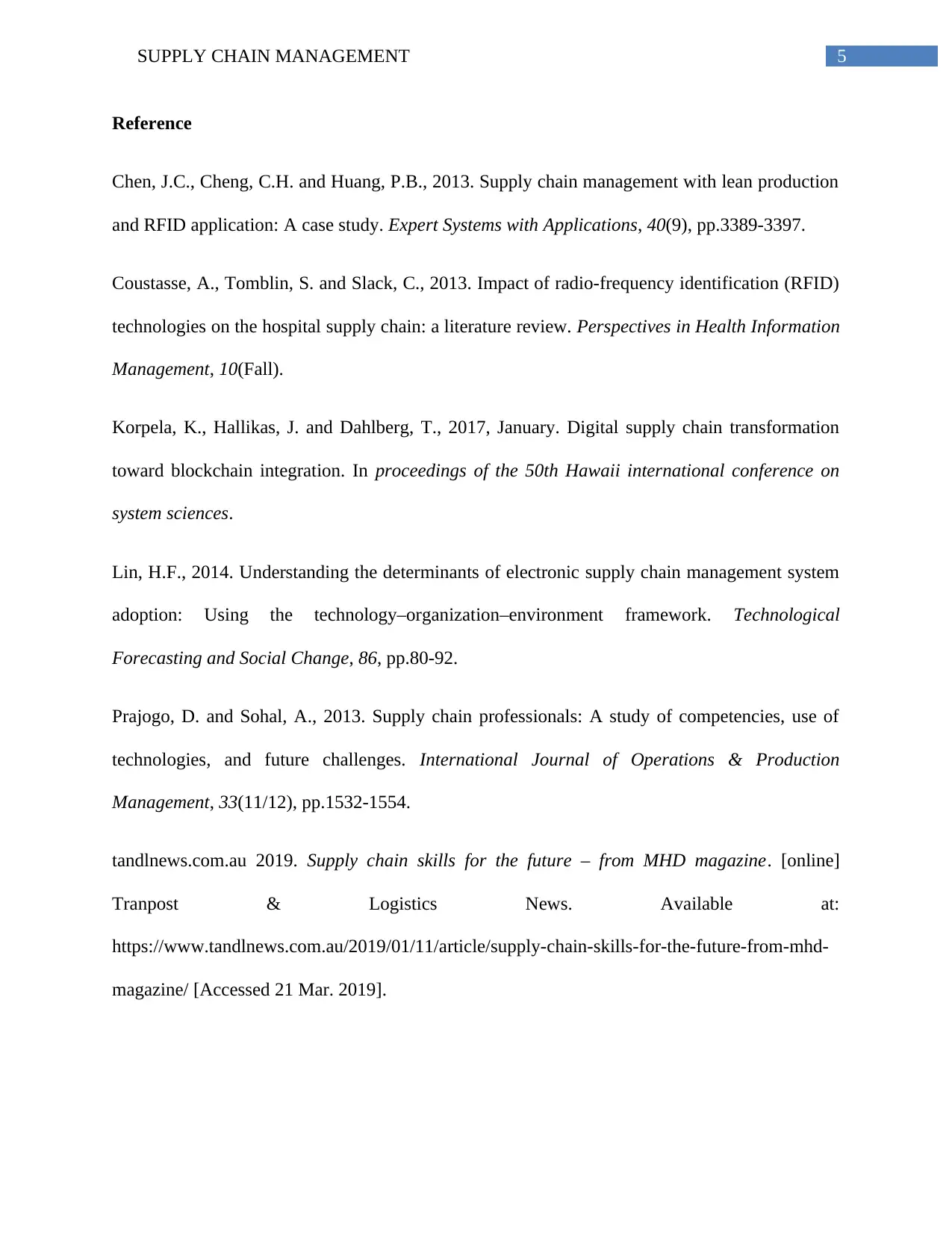
5SUPPLY CHAIN MANAGEMENT
Reference
Chen, J.C., Cheng, C.H. and Huang, P.B., 2013. Supply chain management with lean production
and RFID application: A case study. Expert Systems with Applications, 40(9), pp.3389-3397.
Coustasse, A., Tomblin, S. and Slack, C., 2013. Impact of radio-frequency identification (RFID)
technologies on the hospital supply chain: a literature review. Perspectives in Health Information
Management, 10(Fall).
Korpela, K., Hallikas, J. and Dahlberg, T., 2017, January. Digital supply chain transformation
toward blockchain integration. In proceedings of the 50th Hawaii international conference on
system sciences.
Lin, H.F., 2014. Understanding the determinants of electronic supply chain management system
adoption: Using the technology–organization–environment framework. Technological
Forecasting and Social Change, 86, pp.80-92.
Prajogo, D. and Sohal, A., 2013. Supply chain professionals: A study of competencies, use of
technologies, and future challenges. International Journal of Operations & Production
Management, 33(11/12), pp.1532-1554.
tandlnews.com.au 2019. Supply chain skills for the future – from MHD magazine. [online]
Tranpost & Logistics News. Available at:
https://www.tandlnews.com.au/2019/01/11/article/supply-chain-skills-for-the-future-from-mhd-
magazine/ [Accessed 21 Mar. 2019].
Reference
Chen, J.C., Cheng, C.H. and Huang, P.B., 2013. Supply chain management with lean production
and RFID application: A case study. Expert Systems with Applications, 40(9), pp.3389-3397.
Coustasse, A., Tomblin, S. and Slack, C., 2013. Impact of radio-frequency identification (RFID)
technologies on the hospital supply chain: a literature review. Perspectives in Health Information
Management, 10(Fall).
Korpela, K., Hallikas, J. and Dahlberg, T., 2017, January. Digital supply chain transformation
toward blockchain integration. In proceedings of the 50th Hawaii international conference on
system sciences.
Lin, H.F., 2014. Understanding the determinants of electronic supply chain management system
adoption: Using the technology–organization–environment framework. Technological
Forecasting and Social Change, 86, pp.80-92.
Prajogo, D. and Sohal, A., 2013. Supply chain professionals: A study of competencies, use of
technologies, and future challenges. International Journal of Operations & Production
Management, 33(11/12), pp.1532-1554.
tandlnews.com.au 2019. Supply chain skills for the future – from MHD magazine. [online]
Tranpost & Logistics News. Available at:
https://www.tandlnews.com.au/2019/01/11/article/supply-chain-skills-for-the-future-from-mhd-
magazine/ [Accessed 21 Mar. 2019].
⊘ This is a preview!⊘
Do you want full access?
Subscribe today to unlock all pages.

Trusted by 1+ million students worldwide
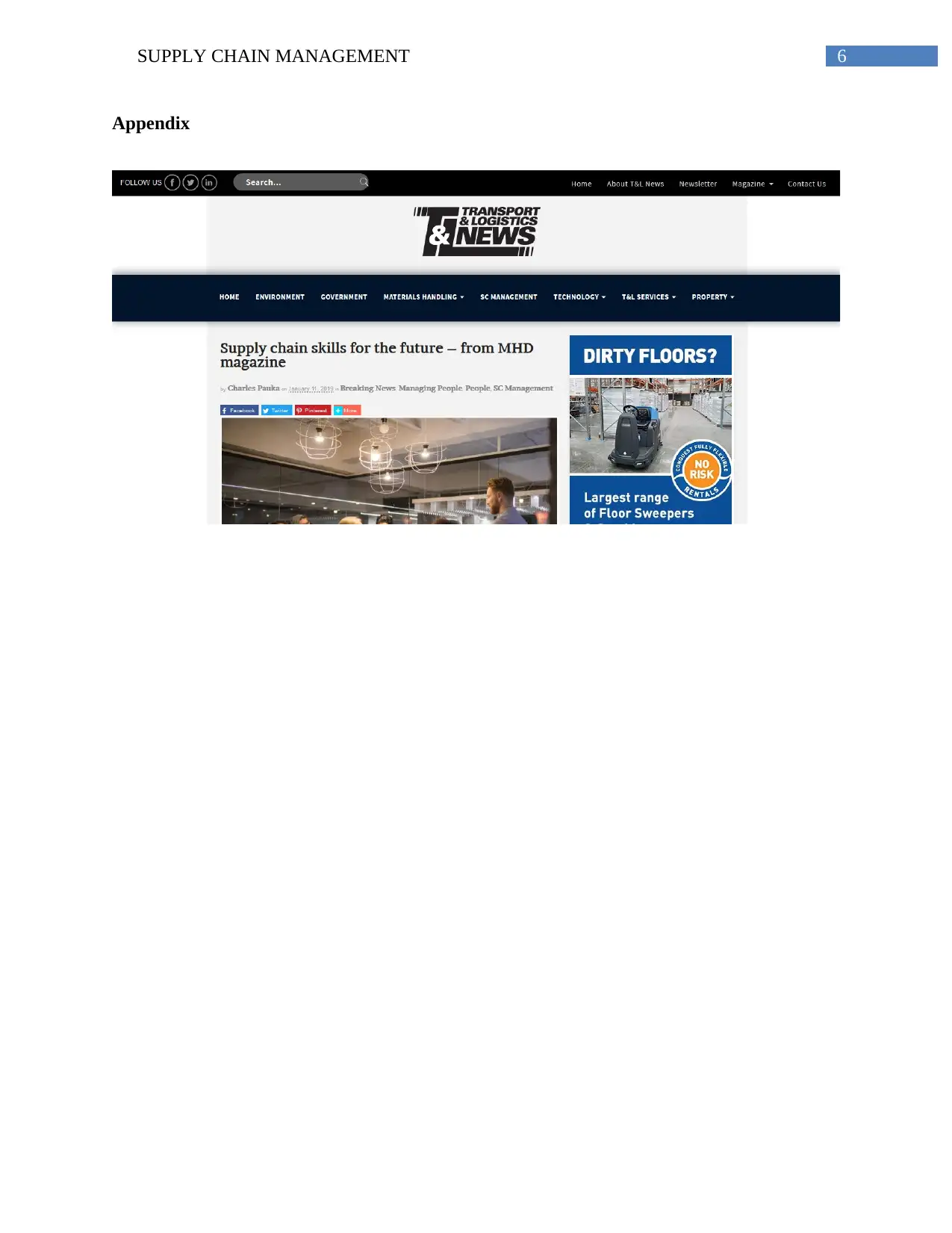
6SUPPLY CHAIN MANAGEMENT
Appendix
Appendix
Paraphrase This Document
Need a fresh take? Get an instant paraphrase of this document with our AI Paraphraser

7SUPPLY CHAIN MANAGEMENT
1 out of 8
Related Documents
Your All-in-One AI-Powered Toolkit for Academic Success.
+13062052269
info@desklib.com
Available 24*7 on WhatsApp / Email
![[object Object]](/_next/static/media/star-bottom.7253800d.svg)
Unlock your academic potential
Copyright © 2020–2025 A2Z Services. All Rights Reserved. Developed and managed by ZUCOL.





